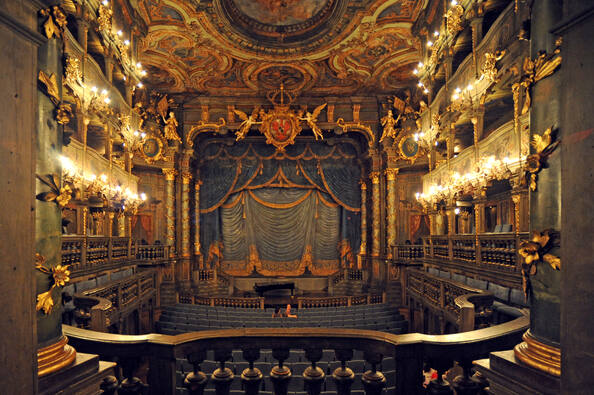Ópera de los Margraves de Bayreuth
Margravial Opera House Bayreuth
A masterpiece of Baroque theatre architecture, built between 1745 and 1750, the Opera House is the only entirely preserved example of its type where an audience of 500 can experience Baroque court opera culture and acoustics authentically, as its auditorium retains its original materials, i.e. wood and canvas. Commissioned by Margravine Wilhelmine, wife of Frederick, Margrave of Brandenburg–Bayreuth, it was designed by the renowned theatre architect Giuseppe Galli Bibiena. As a court opera house in a public space, it foreshadowed the large public theatres of the 19th century. The highly decorated theatre’s tiered loge structure of wood with illusionistic painted canvas represents the ephemeral ceremonial architectural tradition that was employed in pageants and celebrations for princely self-representation.
Description is available under license CC-BY-SA IGO 3.0
Opéra margravial de Bayreuth
Ce chef-d’œuvre de l’architecture théâtrale baroque, construit entre 1745 et 1750, est le seul exemple entièrement conservé de l’architecture de l’opéra de cour. Cinq cents personnes peuvent y apprécier de façon authentique la culture et l’acoustique des opéras baroques, dans un décor où subsistent des éléments en bois et des toiles peintes d’origine. Commandé par la margravine Wilhelmine, épouse de Frédéric, margrave de Brandebourg-Bayreuth, l’opéra a été conçu par Giuseppe Galli Bibiena, architecte réputé. En tant qu’opéra de cour érigé dans un espace public (et non dans un palais), il annonce les grands opéras publics du XIXe siècle. La loge de la Cour, avec ses deux niveaux, marie le bois et les toiles peintes ; cette structure à colombage très décorée est un exemple de l’architecture éphémère qui joua un rôle exceptionnel dans les cérémonies et les parades d’auto-représentation de la Cour.
Description is available under license CC-BY-SA IGO 3.0
Ópera de los Margraves de Bayreuth
Obra maestra de la arquitectura teatral del Barroco, construida entre 1745 y 1750, este teatro de ópera cortesana es el único en su género que se conserva intacto. Los quinientos espectadores que puede albergar su recinto tienen la oportunidad de revivir la cultura operística barroca, incluso en el plano acústico, ya que el teatro ha conservado sus materiales de construcción primigenios, como la madera y la tela. Su construcción fue ordenada por Guillermina de Prusia, esposa del margrave Federico de Brandenburgo-Bayreuth, y su diseño se debe al afamado arquitecto teatral Giuseppe Galli Bibiena. Por ser un teatro de ópera cortesana edificado como elemento integrante del espacio urbano público, se puede decir que prefiguró los grandes teatros públicos del siglo XIX. El palco a dos niveles de los soberanos, con su rica ornamentación de madera y lienzo pintado, es un ejemplo muy representativo de la arquitectura ceremonial efímera utilizada para realzar el boato principesco en festividades y celebraciones.
source: UNESCO/CPE
Description is available under license CC-BY-SA IGO 3.0
バイロイト辺境伯のオペラハウス
バイエルン州バイロイトにあるオペラハウスで、バロック劇場建築の傑作。ブランデンブルク-バイロイト辺境伯フリードリッヒの妻の命により1745~50年に建てられ、著名な劇場建築家のジュゼッペ・ガッリ・ビビエーナが設計を担当した。宮殿の一部ではなく独立した劇場である点が貴重で、500人もの収容人員を持つこの劇場は、19世紀の大規模公共劇場の先駆的存在とされている。また、当時流行した同種の劇場の中で、この劇場は絵画も含めた内装が唯一完全に保存されている点でも貴重である。source: NFUAJ
Markgraaf opera Bayreuth
De Markgraaf opera werd gebouwd tussen 1745 en 1750 en is een meesterwerk van barok theaterarchitectuur. Het is het enige compleet bewaarde voorbeeld van zijn soort, waar een gehoor van 500 man authentiek de barokke hofoperacultuur en akoestiek kan ervaren omdat het auditorium nog zijn originele materialen – hout en canvas – heeft. Het operagebouw is ontworpen door de befaamde theaterarchitect Giuseppe Galli Bibiena, in opdracht van gravin Wilhelmine, de vrouw van Frederick, markgraaf van Brandenburg-Bayreuth. De hofopera stond op publiek terrein en was daarmee de voorbode van de grote publieke theaters van de 19e eeuw.
Source: unesco.nl
